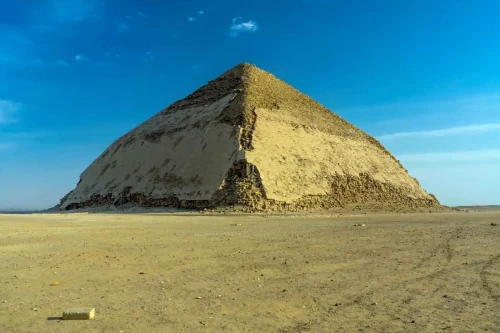
Info About How Bent Pyramid built
There are a few hypotheses about how the Bent Pyramid was built and you will know them with Egypt tours, the most generally acknowledged hypothesis is that it was built utilizing a conventional strategy known as "layering." This technique included the development of a progression of concentric layers of stone blocks, with each layer being marginally more modest than the one underneath it. The blocks were painstakingly sliced and molded to fit together cozily, and were held set up by a combination of mud and mud.
The construction of the Bent Pyramid probably required a huge labor force of talented specialists, including bricklayers, woodworkers, and metalworkers. It is felt that the pyramid was constructed utilizing different devices, including etches, mallets, and saws. The specialists would have utilized slopes and switches to lift the weighty stone blocks into place, and may have involved pulleys and other basic machines to aid the development cycle.
Regardless of the fact that the Bent Pyramid is over 4,500 years of age and it's one of best Cairo attractions, it remains a great accomplishment of its design and development. Its extraordinary bowed shape and the way that it was quite possibly the earliest obvious pyramid to be inherent Egypt travel packages make it an interesting and significant piece of the country's rich history and cultural heritage.
What is the satellite pyramid?
The Satellite Pyramid of Sneferu is a small pyramid situated close to the bigger Twisted Pyramid and Red Pyramid in Dahshur, Egypt. you will explore all the facts of the pyramids in Egypt with Egypt luxury tours. It was constructed likewise during the rule of Pharaoh Sneferu, and is accepted to have been utilized as a burial place for one of Sneferu's queens. The pyramid is known as the "Satellite Pyramid" since it is found close to the bigger Bent Pyramid and Red Pyramid. It is a generally little pyramid, remaining around 43 feet (13 meters) tall and with a base that acts around 97 feet (30 meters) on each side. The pyramid is made of mud block and has a smooth, cleaned limestone packaging, which has for the most part been stripped away after some time. The pyramid is presently in ruins, with just the lower piece of the pyramid actually standing.
Can I visit the inside of the Bent Pyramid?
Indeed, visiting within the Bent Pyramid is conceivable. The pyramid is available for the visitors on their Egypt days tours and is a famous objective for those keen on ancient Egyptian history and culture.
Nonetheless, it is critical to take note of that meeting the pyramid requires some actual exertion, as the entry to the pyramid is situated around 30 meters (98 feet) over the ground and requires moving up a lofty slant. Guests likewise need to creep through a little, low passage to get to the entombment chamber, the Bent pyramid is very close to the Step pyramid.
It is likewise important that within the pyramid it can be very dull and muggy, and the air can be very old, so bringing an electric lamp and wear open to clothing is suggested.
In general, in the event that you are keen on visiting the Bent Pyramid with Egypt classic tours, it is really smart to design your visit ahead of time and to be ready for the actual difficulties of entering the pyramid. It is likewise smart to enlist an aide, as they can give significant data about the pyramid and its set of experiences as it's one of historical sites in Cairo day tours.
Who also visited the Bent Pyramid?
Here is a list of some famous people who are known to have visited the Bent Pyramid, along with the year of their visit:
- Napoleon Bonaparte - 1798
- Howard Carter - Late 19th/early 20th century
- Mark Twain - 1869
- Agatha Christie - Early 20th century
- Jackie Kennedy - 1962
- Oprah Winfrey - 2006
- William H. Seward - 1855
- John Lloyd Stephens - 1837
- Max Müller - Late 19th century
- Percy Bysshe Shelley - 1818
- Jean-François Champollion - 1828
- Amelia Edwards - Late 19th century
- Gertrude Laffanchy - Late 19th/early 20th century
- Flinders Petrie - Late 19th century
- Theodore Davis - Early 20th century
- Edward R. Ayrton - Late 19th/early 20th century
- Jean-Pierre Pacha - Late 19th century
- Howard Vyse - Late 19th century
- John Hanning Speke - Mid-19th century
- Henry Salt - Late 18th/early 19th century
 English
English
 français
français
 español
español











